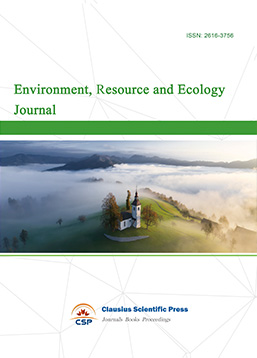Geotechnical Investigation of Subsoils for Foundation Design in Port Harcourt, Nigeria
DOI: 10.23977/geors.2020.030103 | Downloads: 57 | Views: 4649
Author(s)
Ebiegberi Oborie 1, Edirin Akpofure 1
Affiliation(s)
1 Department of Geology, Niger Delta University, Wilberforce Island, Bayelsa State, Nigeria
Corresponding Author
Ebiegberi OborieABSTRACT
Geotechnical investigation was carried out at a proposed construction site in Port Harcourt, to establish the soil profile and determine the engineering geological properties of subsoils in the area. Boring activities were conducted in 4 locations at the site by means of a manual percussion rig to a depth of 30m. Visual observation and laboratory analysis of the recovered samples reveal that the subsurface materials in the area consist of soft clays from the existing ground surface to an average depth of 5.0m. Beneath the clay formation are different sand facies which occur to the final depth of the boreholes. Shallow foundation analysis conducted on the soil samples gave allowable bearing capacity values ranging from 35 -78kN/m2 for square footings founded at depths of 0.5 - 2.0m. Total settlement from the anticipated imposed load of the proposed structure was determined to range between 70 and 52mm at foundation depths of 0.5 and 2.0m for square footing of 1.0m, while settlement for 5.0m footing, was evaluated to be 130 and 80mm at foundation depths of 0.5 and 2.0m respectively. Pile foundation analysis was also carried out for the soil profile encountered at the site. Straight shaft, closed pipe piles of diameters 305, 406, 508 and 610mm were designed. The pile compressive resistance of the 305mm diameter pile was between 20 and 740kN when founded between 5.0 and 30.0m depths respectively, while that of the 610mm diameter pile gave a compressive resistance between 50kN and 1690kN when founded between the same depths. It is therefore recommended that while shallow foundation could be used for supporting structures within the study area, pile foundation should be considered for multi-storey buildings.
KEYWORDS
Borehole, Foundation, Footing, Bearing capacity, Settlement, Compressive resistanceCITE THIS PAPER
Ebiegberi Oborie,Edirin Akpofure, Geotechnical Investigation of Subsoils for Foundation Design in Port Harcourt, Nigeria. Geoscience and Remote Sensing (2020) Vol. 3: 17-28. DOI: http://dx.doi.org/10.23977/geors.2020.030103.
REFERENCES
[1] Roy, S. and Bhalla, S.K. (2017) Role of geotechnical properties of soil on civil engineering structures. Science Academic Publish, 7: 103-109.
[2] Amadi, A.N., Eze, C.J., Igwe, C.O., Okunlola, I.A. and Okoye, N.O. (2012) Architect’s and geologist’s view on the causes of building failures in Nigeria. Modern Applied Science, Vol.6 (6): 31 – 38.
[3] Abija, F.A., Teme, S.C. and Oborie, E. (2018) Geotechnical considerations for the design and construction of foundation in a marshy stream channel of Iwochang-Ibeno, Eastern Niger Delta, Nigeria. J. of Civil, Construction and Environmental Engineering Vol. 3(6), pp. 154 -170.
[4] Mayne, P.W., Christopher, B.R. and DeJong, J. (2002) Subsurface Investigations -Geotechnical Site Characterization No. FHWA NHI-01-031 Federal Highway Administration, U. S. Department of Transportation, Washington D. C
[5] Clayton, C.R.I., Matthews, M.C. and Simons, N.E. (1995) Site Investigation. Blackwell Science, Cambridge, Mass. USA
[6] Teme, S.C. (2002) Geotechnical considerations on foundation design in the Niger Delta. A paper presented at the special technical session of the 39th Annual international conference of the NMGS in Port Harcourt. pp. 51.
[7] Allen, J.R.C. (1965) Late Quaternary Niger Delta and Adjacent Area; Sedimentary Environment and Lithofacies, AAPG Bulletin, Vol. 49, pp. 547-600.
[8] Short, K.C. and Stauble, A.J. (1967) Outline of the Geology of Niger Delta. Bull A.A.P.G., 51, 761-779.
[9] Onyeagucha, A.C. (1980) Petrography and Depositional Environment of the Benin Formation. J. Min. Geol. 17, pp. 47-51.
[10] Asseez, L.O. (1989) Review of the stratigraphy, sedimentation and structure of the Niger Delta. In: C.A Kogbe (ed.) Geology of Nigeria. Rockview Nigeria Limited, pp. 311 -324
[11] Gobo, A.E., 1988. Meteorology and Man’s Environment. African Link Books, Ibadan, Nigeria, pp. 118 -119.
[12] Akintola, J.O. (1986) Rainfall Distribution in Nigeria 18921983. Impact Publishers, Ibadan, pp. 180 – 192.
[13] Abam, T.K.S. (1996) Soil Exploration and Foundations in the Recent Coastal Areas of Nigeria. Bulletin of the International Association of Engineering Geology, Paris, 53.
[14] Terzaghi K. (1943). Theoretical soil mechanics. John Wiley and Sons, New York. pp. 510.
[15] BS EN 1997- 1:2004 Eurocode 7: Geotechnical Design- Part 1 & 2: General Rules, Ground investigation and testing
| Downloads: | 1064 |
|---|---|
| Visits: | 110175 |
Sponsors, Associates, and Links
-
International Journal of Geological Resources and Geological Engineering

-
Big Geospatial Data and Data Science

-
Solid Earth and Space Physics

-
Environment and Climate Protection

-
Journal of Cartography and Geographic Information Systems

-
Environment, Resource and Ecology Journal

-
Offshore and Polar Engineering

-
Physical and Human Geography

-
Journal of Atmospheric Physics and Atmospheric Environment

-
Trends in Meteorology

-
Journal of Coastal Engineering Research

-
Focus on Plant Protection

-
Toxicology and Health of Environment

-
Advances in Physical Oceanography

-
Biology, Chemistry, and Geology in Marine

-
Water-Soil, Biological Environment and Energy

-
Geodesy and Geophysics

-
Journal of Structural and Quaternary Geology

-
Journal of Sedimentary Geology

-
International Journal of Polar Social Research and Review


 Download as PDF
Download as PDF